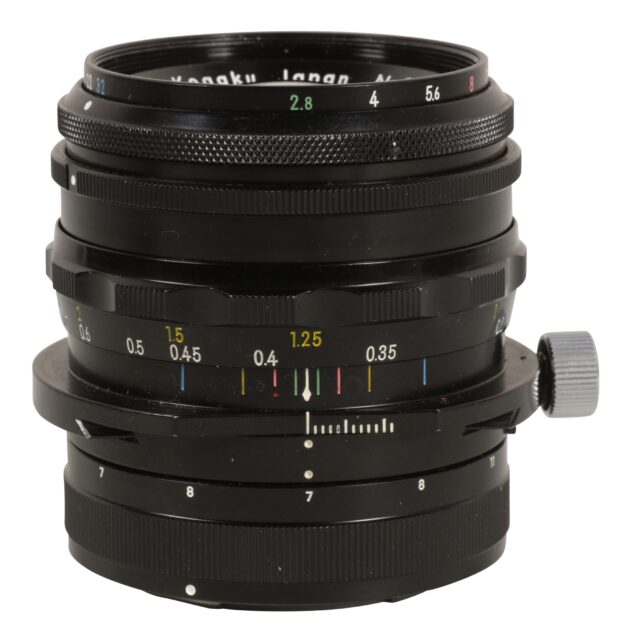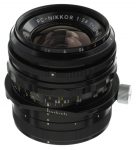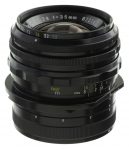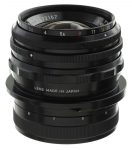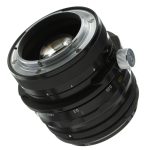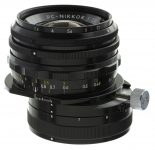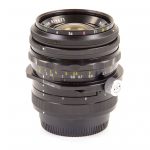Announced
Production status
System
Genres or subjects of photography
Recommended slowest shutter speed when shooting static subjects handheld
Nikon PC-Nikkor 35mm F/2.8
Shift lens • Film era • Discontinued
Abbreviations
| PC | Perspective Control. |
Model history
| ■Nikon PC-Nikkor 35mm F/2.8 | P | 8 - 7 | 0.30m | ⌀52 | 1968 ● | |
| ■Nikon PC-Nikkor 35mm F/2.8 | P | 8 - 7 | 0.30m | ⌀52 | 1975 ● | |
| ■Nikon PC-Nikkor 35mm F/2.8 | P | 7 - 7 | 0.30m | ⌀52 | 1980 ● | |
Specification


| Optical design: | |
| 35mm | |
| F/2.8 | |
| 35mm full frame | |
| Nikon F [46.5mm] | |
| 63.4° (35mm full frame) | |
| 8 elements in 7 groups | |
| Diaphragm mechanism: | |
Diaphragm type: | Preset |
Aperture control: | Preset ring + Aperture ring |
| 9 (nine) | |
| Focusing: | |
| 0.3m | |
| <No data> | |
Focusing modes: | Manual focus only |
Manual focus control: | Focusing ring |
| Perspective control mechanism: | |
Shift range: | 0..11mm |
Tilt range: | Not available |
| Yes | |
| - | |
| Physical characteristics: | |
| 335g | |
| ⌀70×62mm | |
| Accessories: | |
| Screw-type 52mm | |
| HN-1 - Screw-type round | |
| Not compatible |
Sources of data
- Manufacturer's technical data.
- Nikon/Nikkormat Sales Manual (March 1972).
- Nikon F2 Photography Guide.
- Nikkor lenses for Nikon and Nikkormat cameras.
Manufacturer description #1
It was Nikon that brought perspective correction to 35mm by means of the ingenious PC-Nikkor lens.
Normally, when photographing a building, the camera may have to be tilted to include the upper part of the structure. This causes the vertical lines to converge toward the top and gives the building the appearance of leaning or falling back.
Previously, the only solution was to use a view camera, keeping its back parallel to the building and raising the lens standard to bring the upper part into the picture.
In the PC-Nikkor, a micrometer lead-screw permits shifting the optics off-axis by as much as 11 mm. A mm-calibrated scale shows the extent of the shift. This 11mm shift in the PC-Nikkor is equivalent to a 3-inch shift on a view camera equipped with a 9-1/2 inch lens.
For example shooting a building from a distance of about 200 feet, an 11 mm upward shift of the lens will bring about 72 feet more of the upper structure into the picture.
Because the entire lens assembly can rotate in the mount of the PC-Nikkor, the effect of the shift can be applied vertically (up or down), horizontally (either side), or diagonally. There are 12 click-stop positions at 30° intervals.
The PC-Nikkor may also be used to produce "wide-field" pictures with uniform perspective (unlike those made with rotating pan heads). Two pictures, each taken with the lens shifted the full 11 mm in the opposite extreme, can be joined where they overlap to produce a single extended photograph. The technique can be used on vertical or horizontal subjects.
In its normal position, the PC-Nikkor is an excellent intermediate (62°) wideangle lens with focusing range as close as 12 inches.
Manufacturer description #2
Through its ingenious perspective control, the PC-Nikkor brings view-camera versatility to 35mm photography. Its frontal shifting 11mm off-center in any direction controls the parallels of structures. In addition to its obvious application in architectural recording, this remarkable lens is also very effective for commercial and industrial photography. And by shifting the lens vertically or horizontally without moving the camera, you can take a series of two pictures for an exactly matching panoramic shot. Focusing screen Type E is especially suited for this lens.
Manufacturer description #3
Ingeniously designed, the PC-Nikkor permits photography of fairly extensive subjects without tilting or inclining the camera. It provides a facility never before possible, except with large view cameras equipped with swings and tilts and a movable lens board.
The PC-Nikkor is extremely useful in architectural, industrial and commercial photography and where perspective compensation in enlarging the negative is difficult.
In the PC-Nikkor, a micrometer lead screw control permits moving the optics off-center as much as 11mm. The effect is the same as is produced on a view camera having a 3-inch rise and equipped with a 9-1/2-inch lens.
The entire lens mount rotates so that correction can be made in any direction - horizontal, vertical or diagonal. There are 12 click-stop positions at 30 degrees intervals. In the normal position, the lens is also an effective intermediate wideangle with an angle of view of 62 degrees.
Manufacturer description #4
A wideangle lens of retrofocus design, the PC-Nikkor incorporates the lens shifting feature for control of image perspective.
In covering large rectangular subjects, for example, a tall building, the photographer has to tilt his camera upwards to include the top of the structure, especially when working at close range. The result is that in the photograph the walls of the building appear to converge, as if the building were falling over backwards.
With the PC-Nikkor, the photographer is able to shift the lens horizontally, vertically or diagonally to include the top of the building while keeping the film plane parallel to the wall surface to eliminate unwanted converging lines.
The front part of the lens may be shifted by as much as 11 mm off-center by means of a micrometer leadscrew. In addition, the entire lens mount may be rotated a full 360° with click-stops at every 30°.
By combining the parallel movements with full circle rotation, the lens can be shifted to any desired direction by 11 mm.
This feature renders the lens highly valuable for architectural and interior photography, especially when using color or monochrome reversal films which do not accommodate perspective correction in the process of enlargement.
Due to its shifting and rotating mechanism, the diaphragm has to be preset manually. There are eight settings on the aperture scale-from f/2.8 to f/32.
When perspective correction is not required, the PC-Nikkor may be used as a conventional medium wideangle lens with excellent results.
The photographer may also take advantage of the shifting movements of the PC-Nikkor to make panoramic pictures by joining two exposures. Its advantage over an ordinary lens mounted on a panoramic equipment is that it is able to maintain the film plane parallel to the subject at all times, and hence, the pictures will match perfectly.
As long as the film is in the vertical plane - the camera held parallel to the subject - there is no perspective distortion. But shooting in this position with a conventional lens frequently produces unbalanced* composition. When photographing a tall building, for instance, the top of the building is cut off, and unwanted foreground is included because the camera is usually held close to the ground level. To include the top of the building and reduce the foreground, the camera must be tilted, but this results in converging vertical lines. Similar distortions result in horizontal lines when photographing a long line of buildings with the camera tilted.
However, with the PC-Nikkor's shifting and rotating movements, the photographer is able to get balanced composition without tilting the camera. The film plane remains vertical while the center of the lens is placed on the line connecting the center of the subject with that of the film.
Theoretically, the converging verticals would be acceptable in terms of the perspective that is true to life. But the human eye will not psychologically accept such vertical convergence while it is quite prepared to accept the same effect in the horizontal plane.
Obtaining panoramic pictures without perspective distortion
When a conventional lens is used for photographing panoramic scenes by employing a two-section technique, the overlapping portions of the two exposures may not match perfectly when joined. This is because the camera has to be moved after the first exposure to get the second half of the panoramic scene, thereby giving rise to shifts in the film plane. With the PC-Nikkor, two separate exposures can be made without moving the camera. Simply shift the lens vertically or horizontally and shoot the first half of the scene. Then rotate the lens mount a full 180 deg. to make the second exposure. The result is a pair of frames that match perfectly.
How to operate the PC-Nikkor
The PC-Nikkor may be shifted by as much as 11 mm off-center in a plane parallel to the film, and the entire lens mount rotated through a full 360 deg.
Grip the camera parallel to the subject plane and shift the lens by turning the knurled shift knob, observing the correction of perspective distortion and checking how much of the subject is included in the viewfinder. The shift scale, calibrated in millimeters, shows how far the lens has been shifted. The permissible degree of shifts depends on its direction. This is because the picture format is rectangular while the lens produces a circular image area. The numbers engraved on the rotating lens mount indicate the limits beyond which image deterioration occurs.
But it is still possible to compensate for any image distortion by composing in such a way that unimportant background elements, such as sky or earth, are brought to the corners of the frame in the direction of the lens shift.
From the editor
A new faster version of the PC-Nikkor 35mm with a few cosmetic changes. Optically it is far better than its f3.5 predecessor.
Notes
- This non-AI lens was designed for Nikon F, F2, Nikkormat FS, FT, FT2, FTN, EL, ELW 35mm film SLR cameras.
- Non-AI lenses cannot be used on Nikon digital SLR cameras (except for the Df) or late (AI) film SLR cameras. However, non-AI lenses can be fitted to Nikon FM, FE, EL2, F3, F4 and Nikkormat FT3 cameras which used the AI metering system but allowed the metering coupling lever to be disengaged. The F5 could have this mechanism fitted as an optional extra. Non-AI lenses can be also fitted to the Nikon F2A and F2AS cameras because the AI mechanism was fitted to the removable metering prism.
Other shift lenses in the Nikon F system
Sorted by focal length and speed, in ascending order
| ■Nikon F mount (10) | |||||||||
| Nikon PC Nikkor 19mm F/4E ED | A | 17 - 13 | 0.25m | -- | 2016 ● | ||||
| Nikon PC-E Nikkor 24mm F/3.5D ED | A | 13 - 10 | 0.21m | ⌀77 | 2008 ● | ||||
| Nikon PC-Nikkor 28mm F/4 | P | 10 - 8 | 0.30m | ⌀72 | 1975 ● | ||||
| Nikon PC-Nikkor 28mm F/3.5 | P | 9 - 8 | 0.30m | ⌀72 | 1980 ● | ||||
| Nikon PC-Nikkor 35mm F/3.5 | P | 6 - 6 | 0.30m | ⌀52 | 1962 ● | ||||
| Nikon PC-Nikkor 35mm F/2.8 | P | 8 - 7 | 0.30m | ⌀52 | 1975 ● | ||||
| Nikon PC-Nikkor 35mm F/2.8 | P | 7 - 7 | 0.30m | ⌀52 | 1980 ● | ||||
| Nikon PC-E Micro Nikkor 45mm F/2.8D ED | A | 9 - 8 | 0.25m | ⌀77 | 2008 ● | ||||
| Nikon PC Micro Nikkor 85mm F/2.8D | M | 6 - 5 | 0.39m | ⌀77 | 1999 ● | ||||
| Nikon PC-E Micro Nikkor 85mm F/2.8D | A | 6 - 5 | 0.39m | ⌀77 | 2008 ● | ||||
Lenses with similar focal length
Sorted by manufacturer name
| ■Interchangeable mount (2) | |||||||||
| Schneider-Kreuznach PC-Curtagon 35mm F/4 MC | M | 7 - 6 | 0.30m | ⌀49 | ● | ||||
| Schneider-Kreuznach PA-Curtagon 35mm F/4 | M | 7 - 6 | 0.30m | ⌀49 | 1967 ● | ||||
